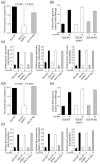Kaposi's Sarcoma-Associated Herpesvirus ORF7 Is Essential for Virus Production
- PMID: 34071710
- PMCID: PMC8228664
- DOI: 10.3390/microorganisms9061169
Kaposi's Sarcoma-Associated Herpesvirus ORF7 Is Essential for Virus Production
Abstract
Kaposi's sarcoma-associated herpesvirus (KSHV) causes Kaposi's sarcoma, primary effusion lymphoma (PEL), and multicentric Castleman disease. Although capsid formation and maturation in the alpha-herpesvirus herpes simplex virus 1 are well understood, these processes in KSHV remain unknown. The KSHV ORF7, encoding the viral terminase (DNA cleavage and packaging protein), is thought to contribute to capsid formation; however, functional information is lacking. Here, we investigated the role of ORF7 during KSHV lytic replication by generating two types of ORF7 knock-out (KO) mutants (frameshift-induced and stop codon-induced ORF7 deficiency), KSHV BAC16, and its revertants. The results revealed that both ORF7-KO KSHVs showed significantly reduced viral production but there was no effect on lytic gene expression and viral genome replication. Complementation assays showed virus production from cells harboring ORF7-KO KSHV could be recovered by ORF7 overexpression. Additionally, exogenously expressed ORF7 partially induced nuclear relocalization of the other terminase components, ORF29 and ORF67.5. ORF7 interacted with both ORF29 and ORF67.5, whereas ORF29 and ORF67.5 failed to interact with each other, suggesting that ORF7 functions as a hub molecule in the KSHV terminase complex for interactions between ORF29 and ORF67.5. These findings indicate that ORF7 plays a key role in viral replication, as a component of terminase.
Keywords: Kaposi’s sarcoma-associated herpesvirus; ORF7; capsid formation; herpesvirus; lytic replication; terminase.
Conflict of interest statement
The authors declare no conflict of interest.
Figures





Similar articles
-
The Contribution of Kaposi's Sarcoma-Associated Herpesvirus ORF7 and Its Zinc-Finger Motif to Viral Genome Cleavage and Capsid Formation.J Virol. 2022 Sep 28;96(18):e0068422. doi: 10.1128/jvi.00684-22. Epub 2022 Sep 8. J Virol. 2022. PMID: 36073924 Free PMC article.
-
Kaposi's Sarcoma-Associated Herpesvirus ORF67.5 Functions as a Component of the Terminase Complex.J Virol. 2023 Jun 29;97(6):e0047523. doi: 10.1128/jvi.00475-23. Epub 2023 Jun 5. J Virol. 2023. PMID: 37272800 Free PMC article.
-
The DNase Activity of Kaposi's Sarcoma-Associated Herpesvirus SOX Protein Serves an Important Role in Viral Genome Processing during Lytic Replication.J Virol. 2019 Apr 3;93(8):e01983-18. doi: 10.1128/JVI.01983-18. Print 2019 Apr 15. J Virol. 2019. PMID: 30728255 Free PMC article.
-
[Replication Machinery of Kaposi's Sarcoma-associated Herpesvirus and Drug Discovery Research].Yakugaku Zasshi. 2019;139(1):69-73. doi: 10.1248/yakushi.18-00164-2. Yakugaku Zasshi. 2019. PMID: 30606932 Review. Japanese.
-
Pathological Features of Kaposi's Sarcoma-Associated Herpesvirus Infection.Adv Exp Med Biol. 2018;1045:357-376. doi: 10.1007/978-981-10-7230-7_16. Adv Exp Med Biol. 2018. PMID: 29896675 Review.
Cited by
-
The Contribution of Kaposi's Sarcoma-Associated Herpesvirus ORF7 and Its Zinc-Finger Motif to Viral Genome Cleavage and Capsid Formation.J Virol. 2022 Sep 28;96(18):e0068422. doi: 10.1128/jvi.00684-22. Epub 2022 Sep 8. J Virol. 2022. PMID: 36073924 Free PMC article.
-
Kaposi's Sarcoma-Associated Herpesvirus ORF21 Enhances the Phosphorylation of MEK and the Infectivity of Progeny Virus.Int J Mol Sci. 2023 Jan 8;24(2):1238. doi: 10.3390/ijms24021238. Int J Mol Sci. 2023. PMID: 36674756 Free PMC article.
-
Kaposi's Sarcoma-Associated Herpesvirus ORF67.5 Functions as a Component of the Terminase Complex.J Virol. 2023 Jun 29;97(6):e0047523. doi: 10.1128/jvi.00475-23. Epub 2023 Jun 5. J Virol. 2023. PMID: 37272800 Free PMC article.
-
Unraveling the Kaposi Sarcoma-Associated Herpesvirus (KSHV) Lifecycle: An Overview of Latency, Lytic Replication, and KSHV-Associated Diseases.Viruses. 2025 Jan 26;17(2):177. doi: 10.3390/v17020177. Viruses. 2025. PMID: 40006930 Free PMC article. Review.
-
The viral packaging motor potentiates Kaposi's sarcoma-associated herpesvirus gene expression late in infection.PLoS Pathog. 2023 Apr 17;19(4):e1011163. doi: 10.1371/journal.ppat.1011163. eCollection 2023 Apr. PLoS Pathog. 2023. PMID: 37068108 Free PMC article.
References
-
- Soulier J., Grollet L., Oksenhendler E., Cacoub P., Cazals-Hatem D., Babinet P., d’Agay M.F., Clauvel J.P., Raphael M., Degos L. Kaposi’s sarcoma-associated herpesvirus-like DNA sequences in multicentric Castleman’s disease. Blood. 1995;86:1276–1280. doi: 10.1182/blood.V86.4.1276.bloodjournal8641276. - DOI - PubMed
-
- Uldrick T.S., Wang V., O’Mahony D., Aleman K., Wyvill K.M., Marshall V., Steinberg S.M., Pittaluga S., Maric I., Whitby D., et al. An interleukin-6-related systemic inflammatory syndrome in patients co-infected with Kaposi sarcoma-associated herpesvirus and HIV but without Multicentric Castleman disease. Clin. Infect. Dis. 2010;51:350–358. doi: 10.1086/654798. - DOI - PMC - PubMed
Grants and funding
LinkOut - more resources
Full Text Sources
Research Materials

